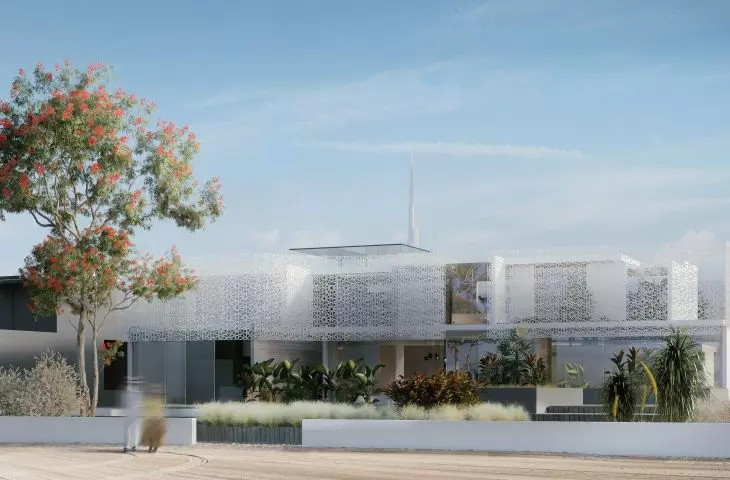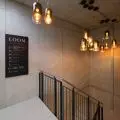The Courtyard House project is the result of a collaboration between Jakub Ciszewski and Tomasz Klepek, architecture students at the Silesian University of Technology, and Mikołaj Chmiel and Oskar Mały of the Sheffield School of Architecture. The concept, which combines modern design, noble materials and references to Arabian ornaments, competed in the Dubai Sea House competition for the design of a luxury villa on the bay in Dubai.
living area overlooking the bay
© Jakub Ciszewski, Mikołaj Chmiel, Tomasz Klepek, Oskar Mały
Dubai Sea House was an international competition organized by the YAC platform, whose challenge was to design a luxury villa on Jumeirah Bay. The property was to be a retreat from the hustle and bustle of the city, a place to relax while enjoying the Persian Gulf. The competition entries were judged by a jury consisting of: Liva Tani (Ateliers Jean Nouvel), Patrick Lüth (SNØHETTA), Peter Pichler (Peter Pichler Architecture), Andrea D "Antrassi (MAD), Fran Silvestre (Fran Silvestre Arquitectos), Jorge P Silva (Aires Mateus Architects). The competition was won by the Somos Terra project by a team composed of Facundo Garcia Berro, Paula Lesch. The jury also awarded second and third prizes, as well as four gold awards and three honorable mentions.
Courtyard House project in Dubai, projections
© Jakub Ciszewski, Mikołaj Chmiel, Tomasz Klepek, Oskar Mały
Courtyard House
Architecture students Jakub Ciszewski, Mikolaj Chmiel, Tomasz Klepek and Oskar Maly also competed in the YAC competition. Their Courtyard House project is an inter-university collaboration, conducted mostly remotely. They placed the building near the Jumeraiah Bay Island peninsula and designed it with clear zoning. A guest area on the first floor houses a living room, open kitchen and spa area, which directly open onto a large garden. The garden visually connects to the beach and the bay, which continues to the less formal -1 level, where a collection of cars provides a backdrop for gatherings. Billiards, a movie theater, gym and bar are also located here. A private zone occupies the first floor - there are a master bedroom and a library, as well as bedrooms and children's playrooms. On the roof, the authors envisioned a green roof with a lodge and a landing pad for a personal drone.
The interior of the master bedroom
© Jakub Ciszewski, Mikołaj Chmiel, Tomasz Klepek, Oskar Mały
playing with the massing
Conceptually, the building derives from a simple solid. On the first floor we opened it up by subtracting cubic spaces from it - courtyards. On the first floor, the bedroom was extended from the solid in order to shield the living room from the sun - this also allowed for a private terrace in the bedroom of the house. We extended the roof beyond the body of the building, protecting the lower floors from overexposure, as well as creating space for an upper terrace. We then surrounded the entire block with an exterior façade that is a modern interpretation of the traditional Arab Mashrabiya, an ornate wooden lattice covering balconies and windows, the authors explain.
The library is located on the first floor of the villa
© Jakub Ciszewski, Mikołaj Chmiel, Tomasz Klepek, Oskar Mały
play of light and shadow
Numerous courtyards bring calm and harmony to the interiors. They limit direct sunlight in the interiors, naturally filtering the sun through layers of greenery. The play of light and shadow enhances the villa's minimalist interiors. Soft northern light subtly illuminates spaces that require more precise lighting. The interiors surround homebuyers with luxury, the neutral colors of travertine, concrete and the warmth of exclusive fabrics.
The building consists of three levels
© Jakub Ciszewski, Mikołaj Chmiel, Tomasz Klepek, Oskar Mały
An important aspect of the entire project was to create a house fully adapted to the needs of people with disabilities. Therefore, we provided for appropriate widths of passageways and heights of, for example, countertops in the kitchen and tables in every part of the villa. One of the rooms has been completely designated for OzN. The building was also equipped with an elevator connecting all floors, the young architects add.


























































